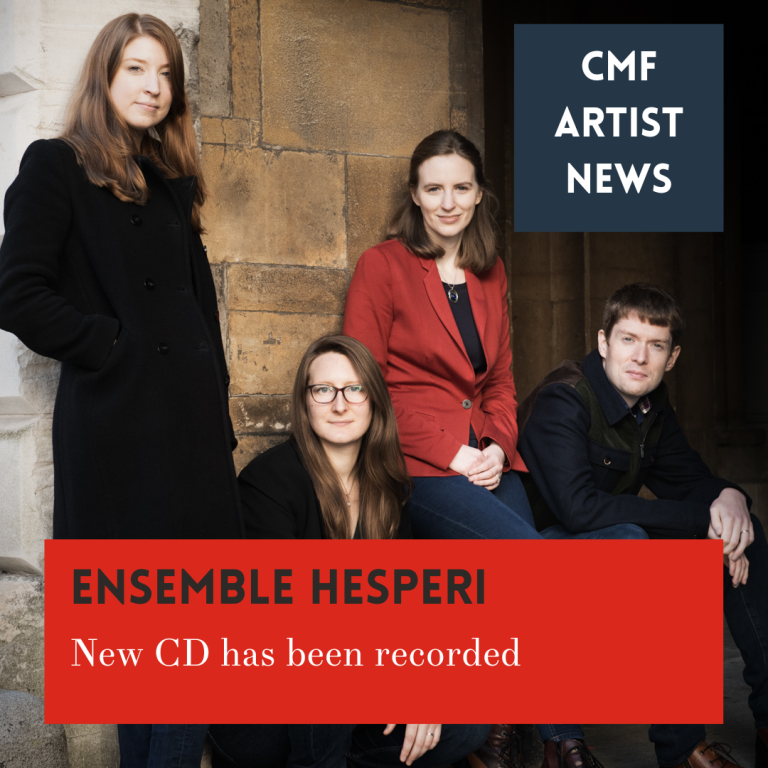City Music Foundation in March
Have a read of the latest upcoming events and news from the CMF Artists this month
This peculiarity mirrors the astonishing gestation of the work: Messiaen was summoned for military service at the start of World War II, captured in May 1940 and taken to the prisoner-of-war camp at Görlitz, with the first performance given in front of a large group of fellow prisoners and guards. The work demonstrates the composers uneasy reconciliation of his devout Catholicism with the horrors of the war. The unusual instrumentation – clarinet, violin, cello and piano – was necessitated by the players he had at his disposal at the camp, and the sequence of eight movements was inspired by the Biblical passage from Revelation: “There shall be time no longer; but on the day of the trumpet of the seventh angel, the mystery of God shall be finished.”
Rehearsing Messiaen’s Quartet for the End of Time is an immensely challenging process. I first learned and performed the work as a teenager at the RCM Junior Department: my first experience
playing Messiaen. The learning process involved actively forcing yourself to reject the traditional norms of the core classical era, as well as assimilating a new rhythmic language. I was drawn to the complete directness of the emotional experience, but also the immense complexity of the score, and the
economy of musical material. Listen out, for example in the second movement to the luminous kaleidoscope of cluster chords in the piano, and how the same passage is transformed in the seventh movement to a vertiginous, terrifying vortex.
There are a great deal of connections with some of the other works by Messiaen I have played – Des
Canyons aux Étoiles, the Vingt Regards and Catalogue d’oiseaux – yet the quartet is in many ways more disjointed. Music of violence and bewildering ferocity is juxtaposed with radiant, harmonious and ecstatic music of the deepest calm. The eternal scope of the work often only reveals itself during performance; perhaps unsurprising given that the full ensemble plays together in only half of the movements.
Rather than a vision of the apocalypse, Messiaen’s instead portrays the end of time as we know it and the beginning of eternity. Linear time is subverted, through the use of palindromic rhythms, the addition or subtraction of small note values, and quoting birdsong. The latter would become an increasing preoccupation for the composer, and Messiaen associated the unencumbered existence of birds and their joyous song as a manifestation of the divine realm.
At the emotional core are the duo movements for strings and piano, both expansive, unfolding melodies in E major at an incredibly slow pace – infinitely slow – as Messiaen marks. In performance it requires a great deal of belief: to play so slowly feels unnatural, and there is a resistance in the performer and audience alike. The transformative power is unique – resistance yields to acceptance, and time is reborn and experienced anew, creating one of the enduring masterpieces of the twentieth century.
Excerpts from Messiaen’s introduction further illuminates the sequence of movements:
I. Liturgy of crystal
Between the morning hours of three and four, the awakening of the birds: a thrush or a nightingale soloist improvises, amid notes of shining sound and a halo of trills high in the trees.
II. Vocalise, for the angel who announces the end of Time
The first and third parts evoke the power of that mighty angel, his hair a rainbow and his clothing mist… Between these sections from the piano, soft cascades of blue-orange chords, encircling with
their distant carillon the plainchant-like recitativo of the violin and cello.
III. Abyss of the birds
Clarinet solo. The abyss is Time, with its sadness and tedium. The birds are the opposite of Time; they are our desire for light, for stars, for rainbows and for jubilant outpourings of song!
IV. Interlude. A Scherzo
V. Praise to the eternity of Jesus
A long phrase, infinitely slow, by the cello expatiates with love
and reverence… the melody unfolds itself at a distance both intimate and
awesome.
VI. Dance of fury, for the seven trumpets
The four instruments in unison give the effect of gongs and trumpets. Music of stone, formidable sonority; movement as irresistible as steel, as huge blocks of livid fury or ice-like frenzy.
VII. Cluster of rainbows, for the angel who announces the end of Time
In my musings, I hear and see ordered melodies and chords, familiar hues and forms; then submit ecstatically to a vortex, a dizzying interpenetration of superhuman sounds and colours.
These fiery swords, these rivers of blue-orange lava, these sudden stars:
Behold the cluster, behold the rainbow!
VIII. Praise to the immortality of Jesus
Expansive violin solo balancing the cello solo of the fifth movement. It is total love. Its slow rising to a supreme point is the ascension of man toward his God, of the Son of God toward his Father, of the mortal newly made divine toward paradise.
NOTATIONS AND SKETCHES
Alexander Soares (piano)
Solo piano works by Boulez, Dutilleux and
Messiaen
Review from Gramophone Magazine – May 2019 –
Editor’s Choice
‘Although most of these pieces have been
collated on various anthologies of French piano music, few of them can match
this new release in its balanced conception or consistency of execution…Soares
has their measure in abundance, resulting in what could hardly be a more
auspicious debut album.’

Available to purchase in St Paul’s Cathedral
after the performance or from https://citymusicfoundation.org/shop/
Have a read of the latest upcoming events and news from the CMF Artists this month

Ensemble Hesperi have successfully crowdfunded for their second album, “A Gift for your Garden” and have now recorded it.
Please help us with a donation…
City Music Foundation
Church House
Cloth Fair
London EC1A 7JQ
Registered Charity No: 1148641
© City Music Foundation 2022 All rights reserved Site by DOT